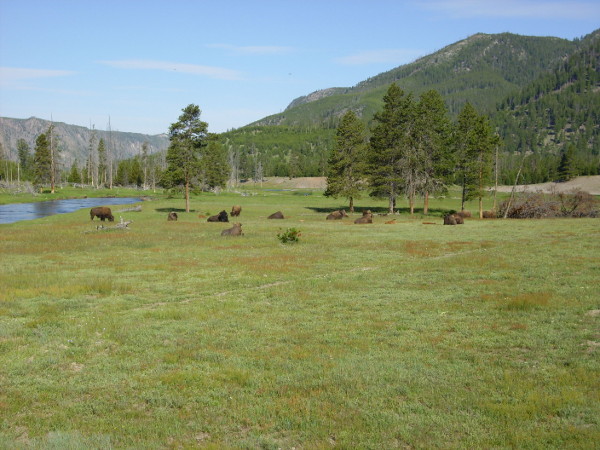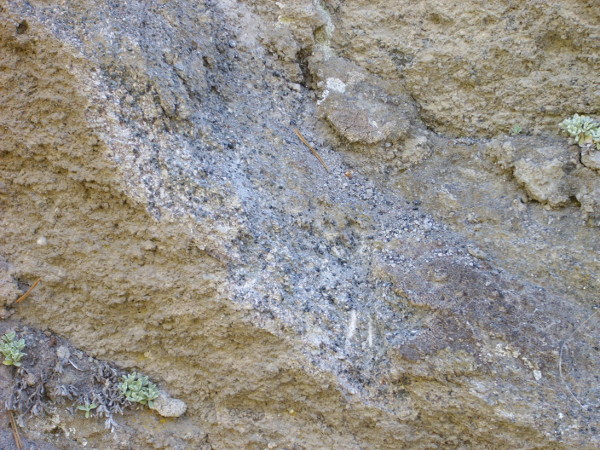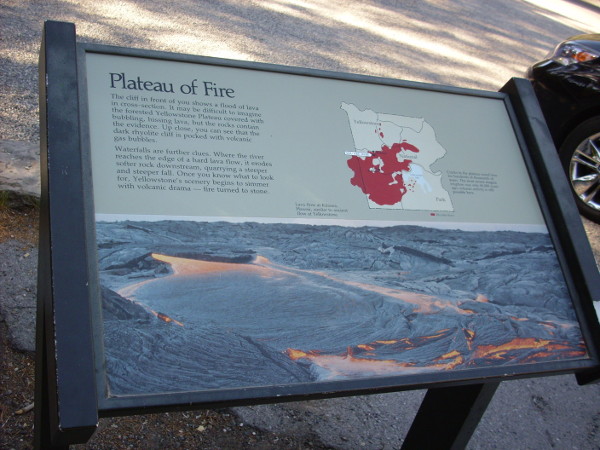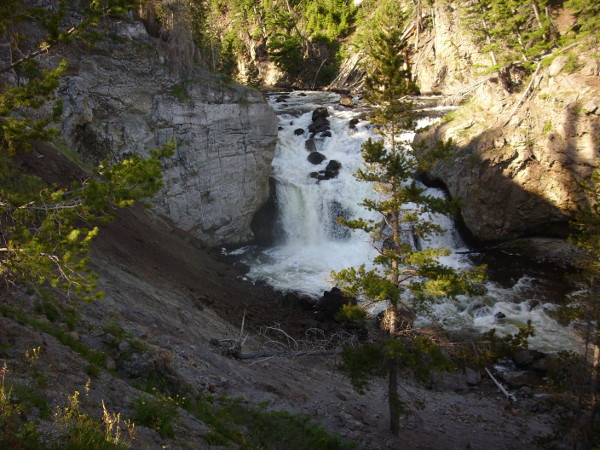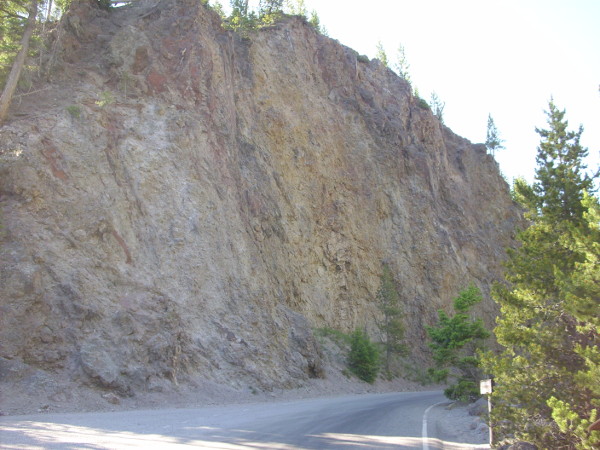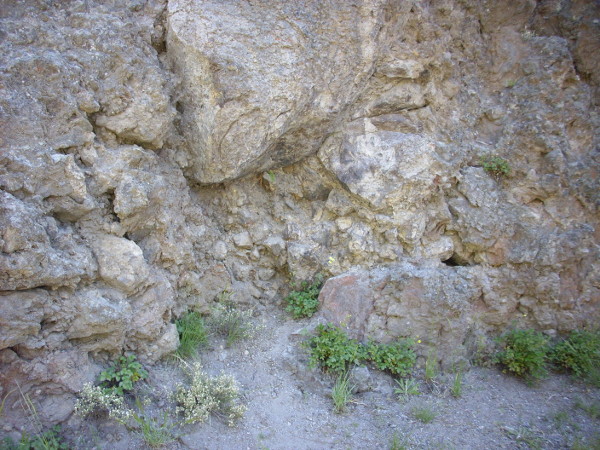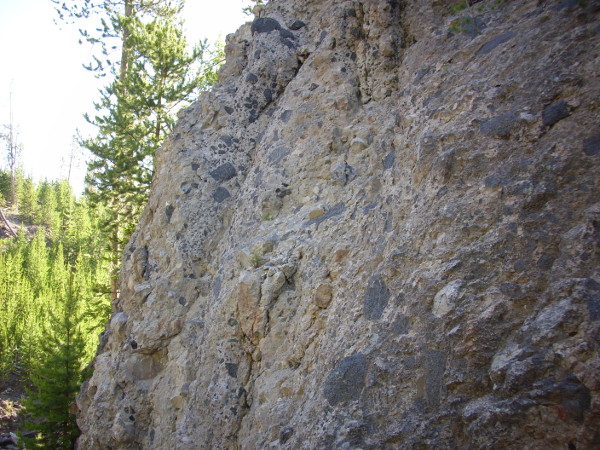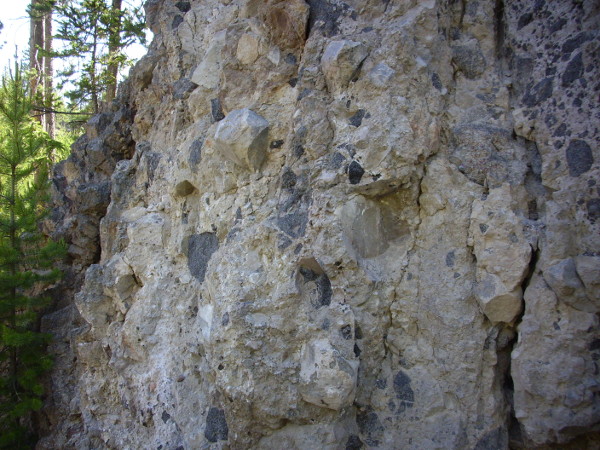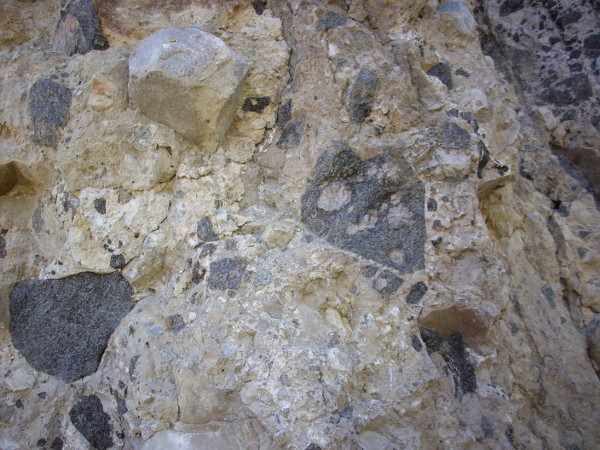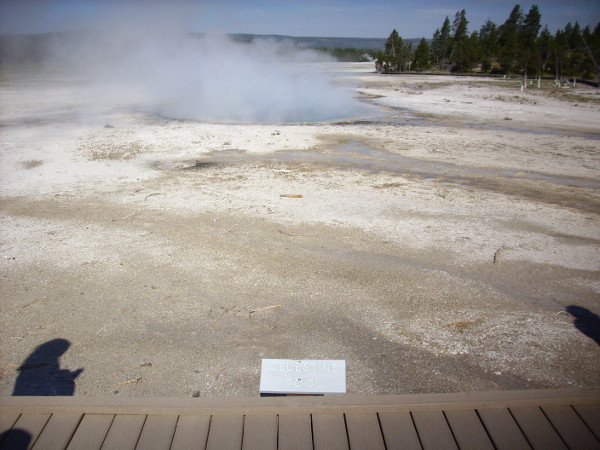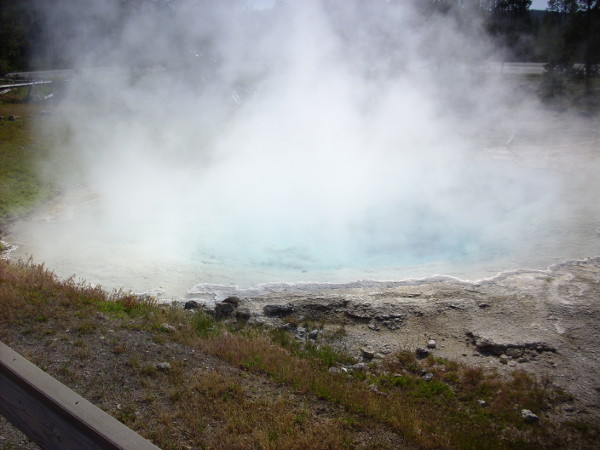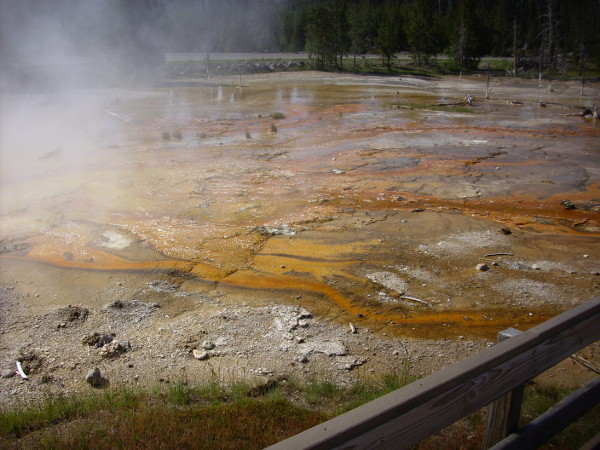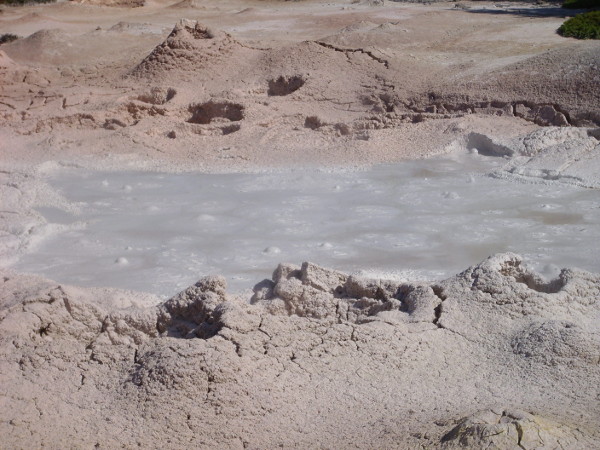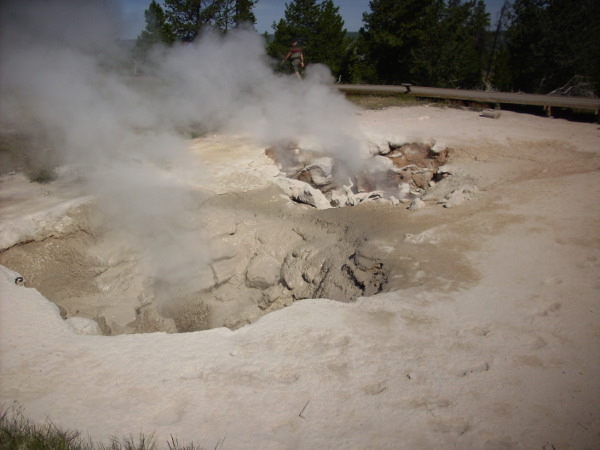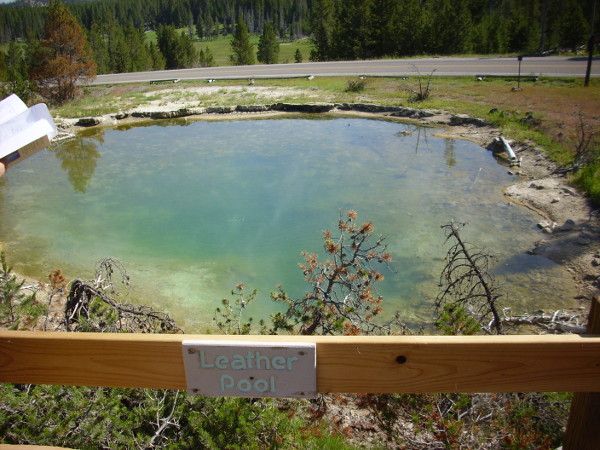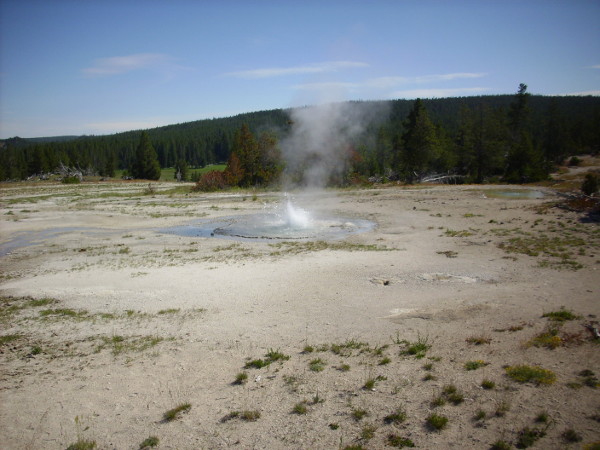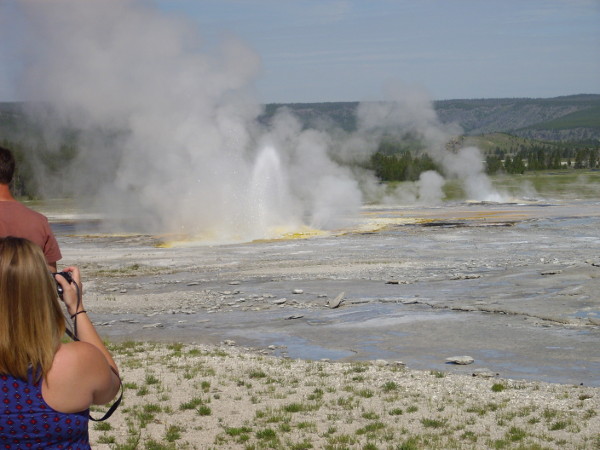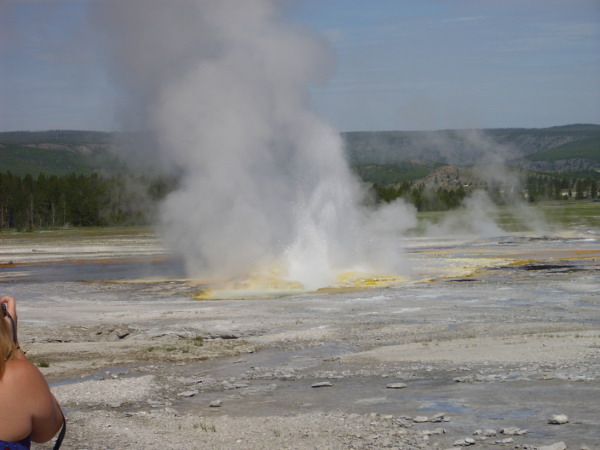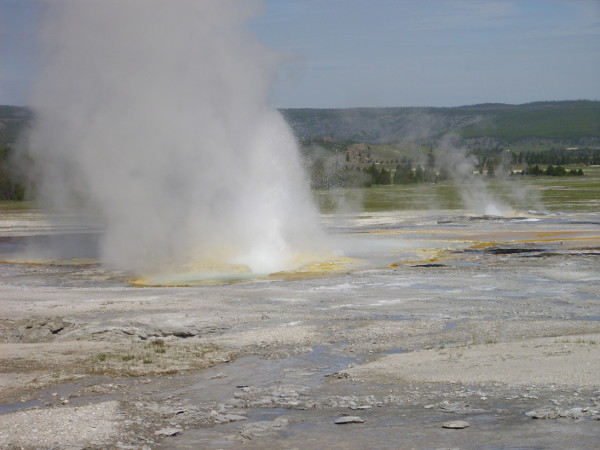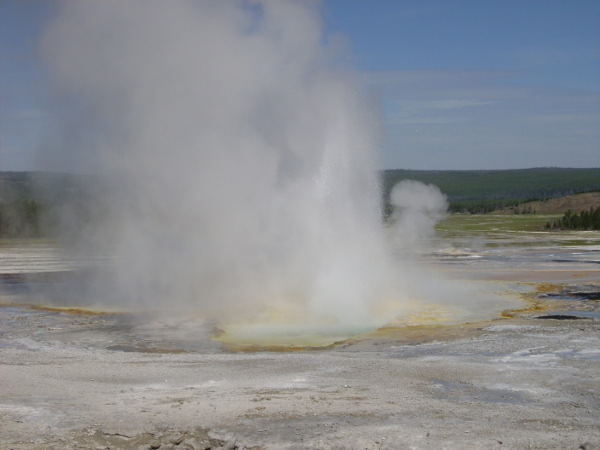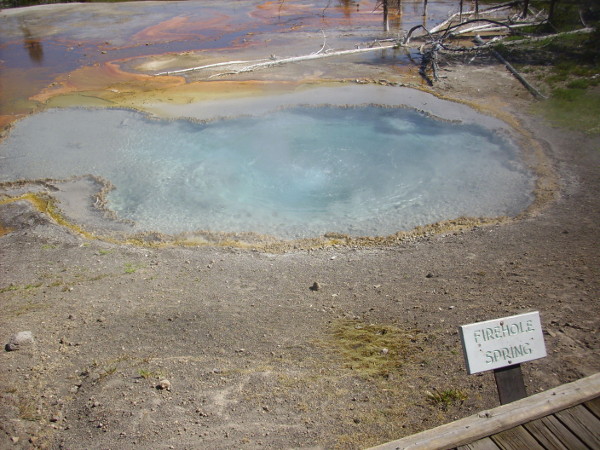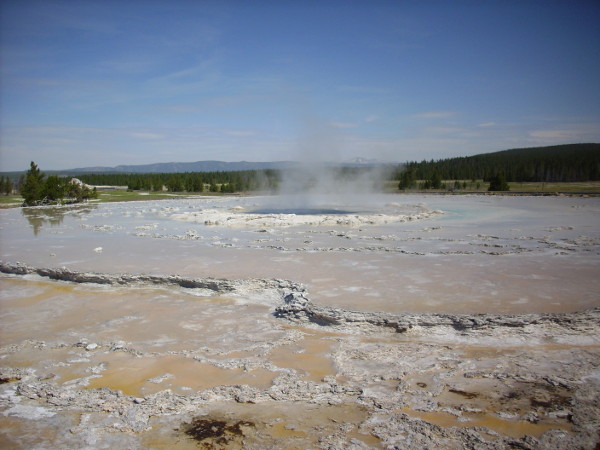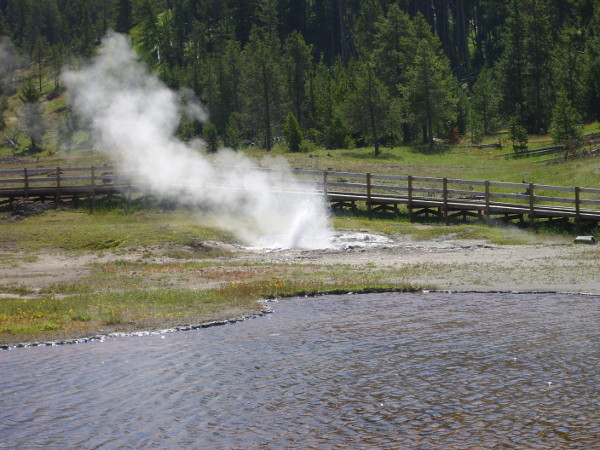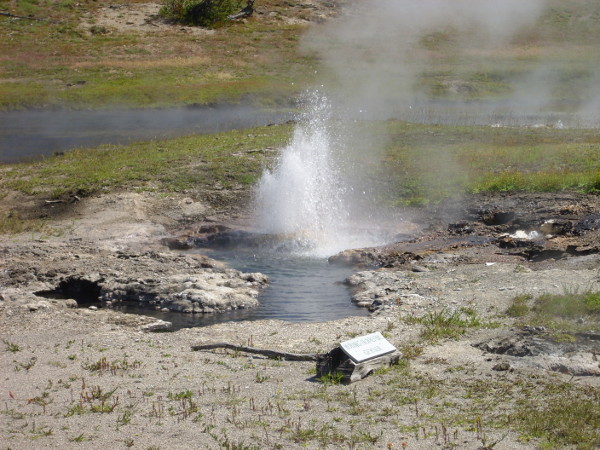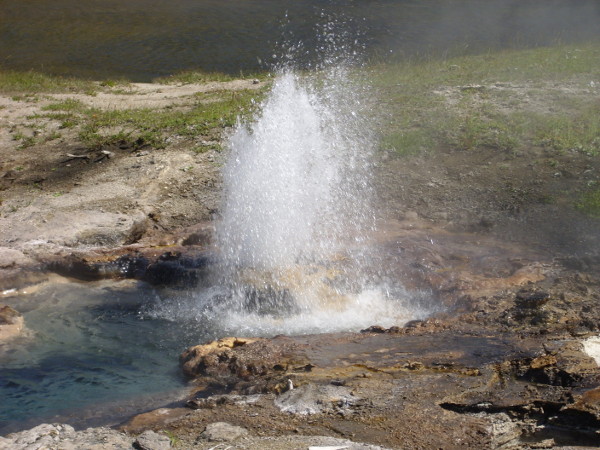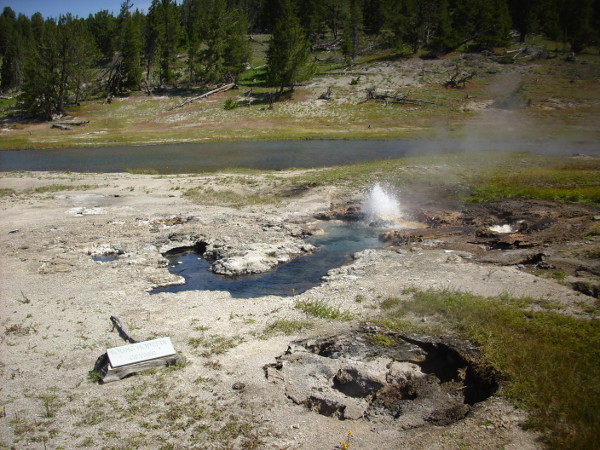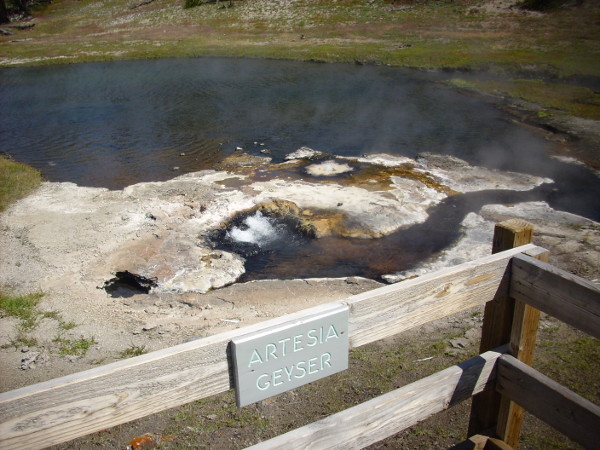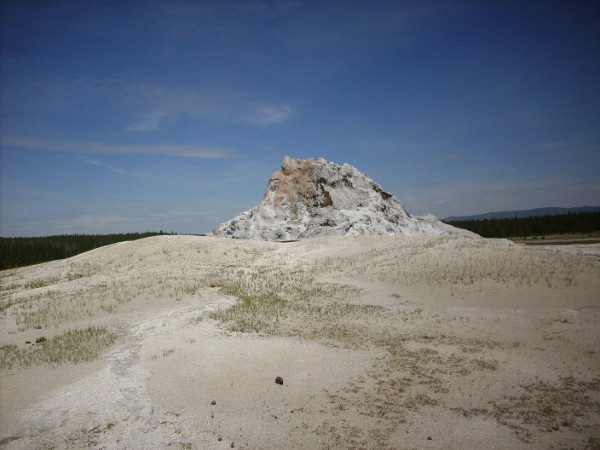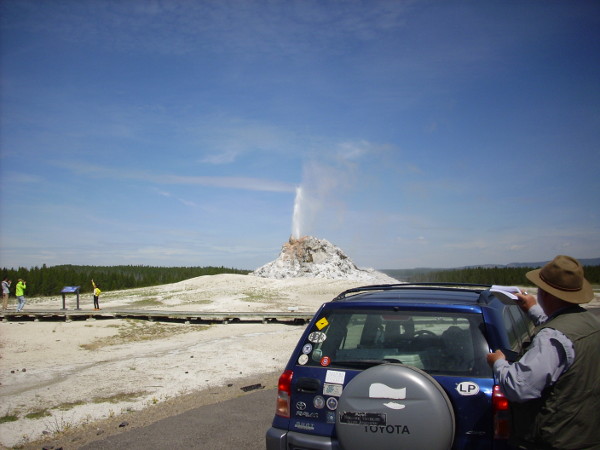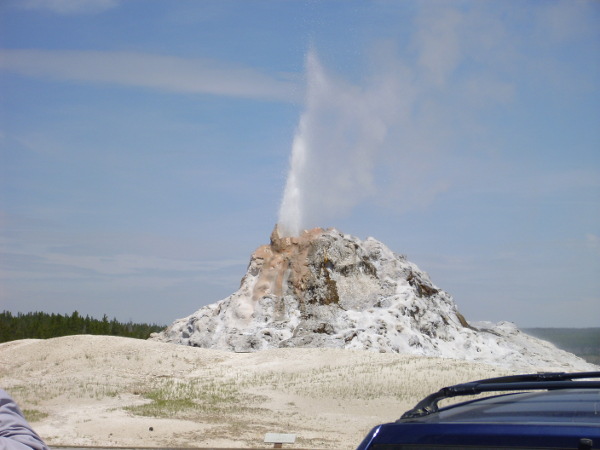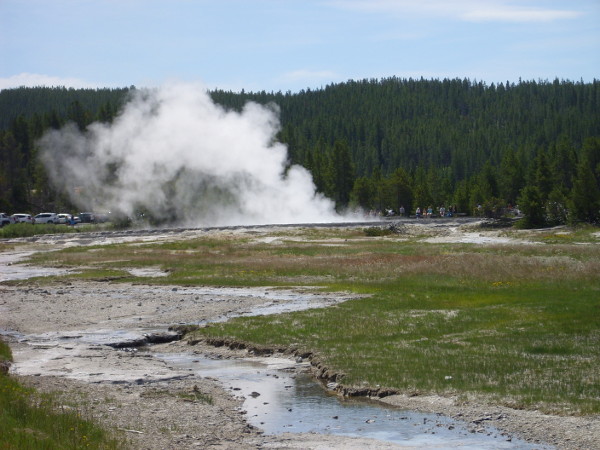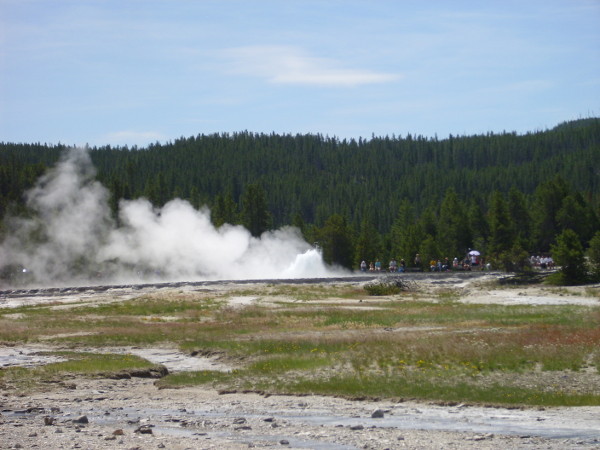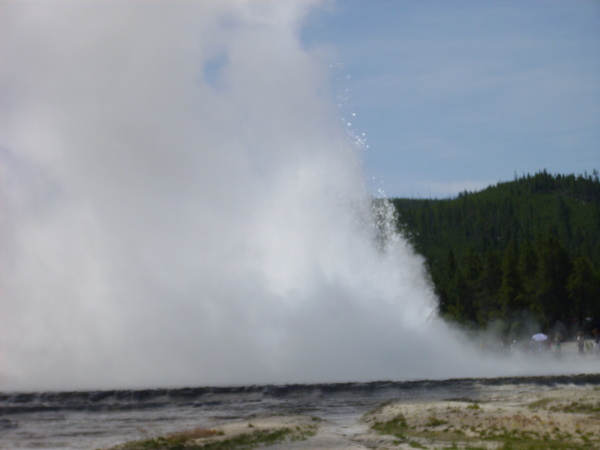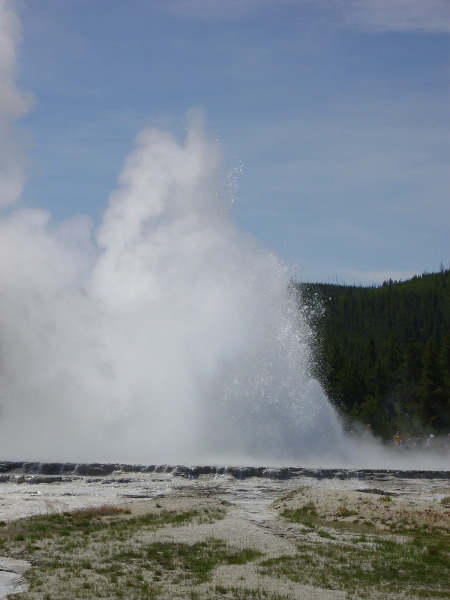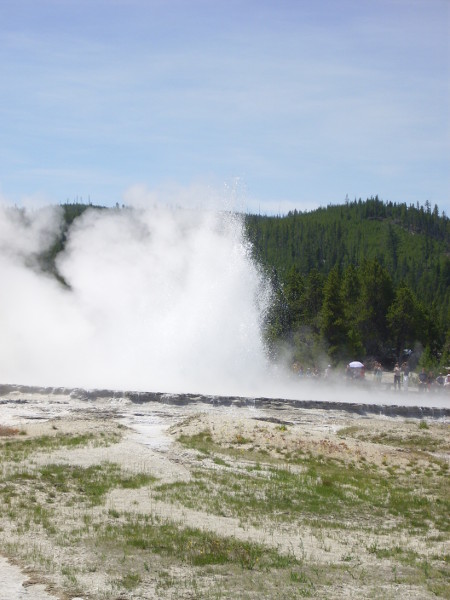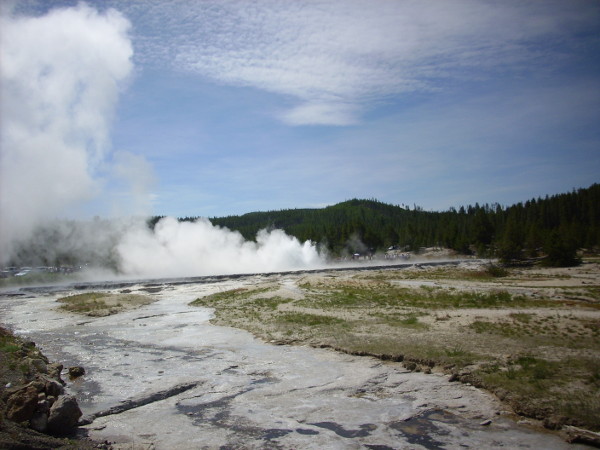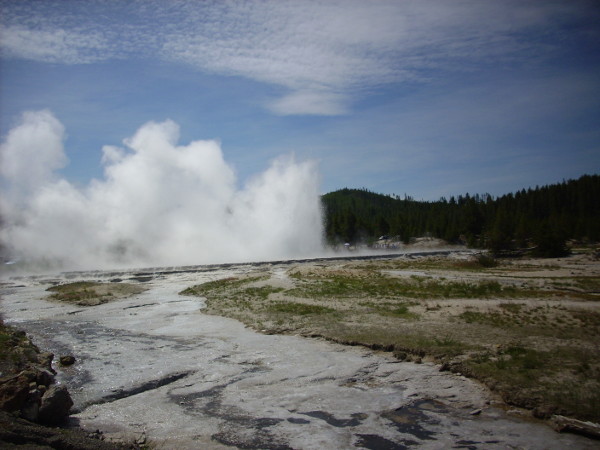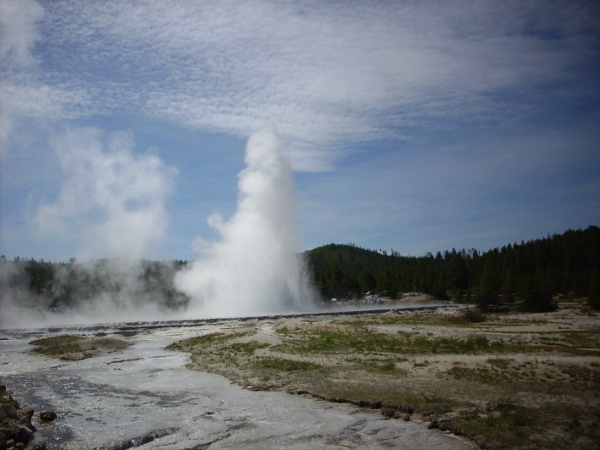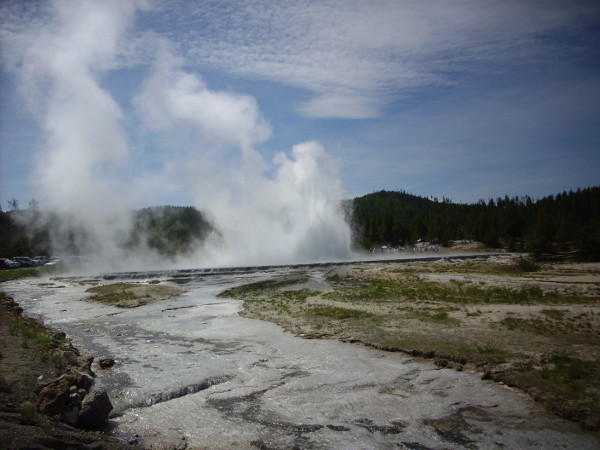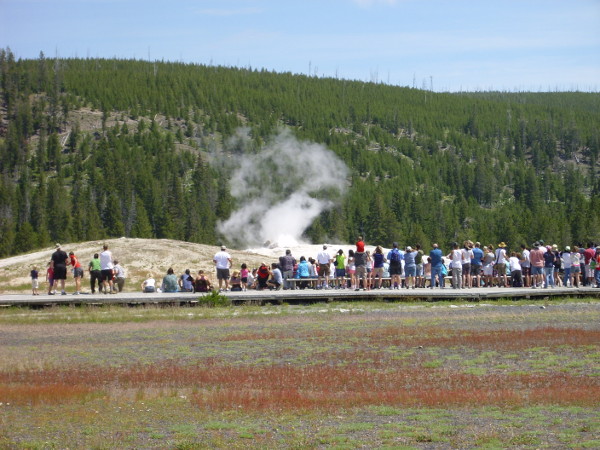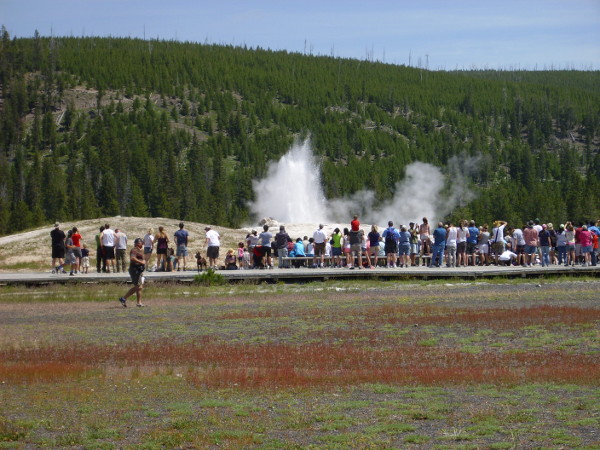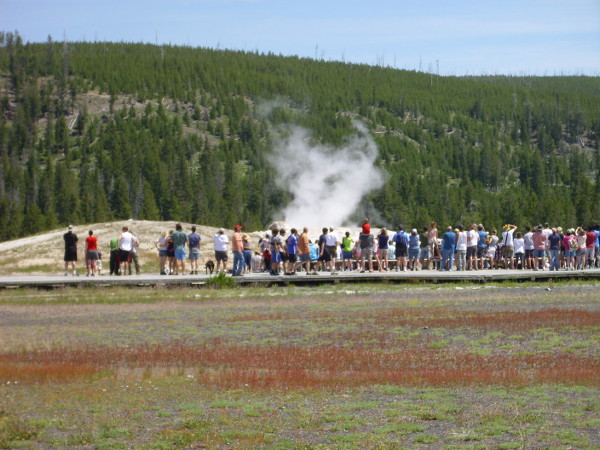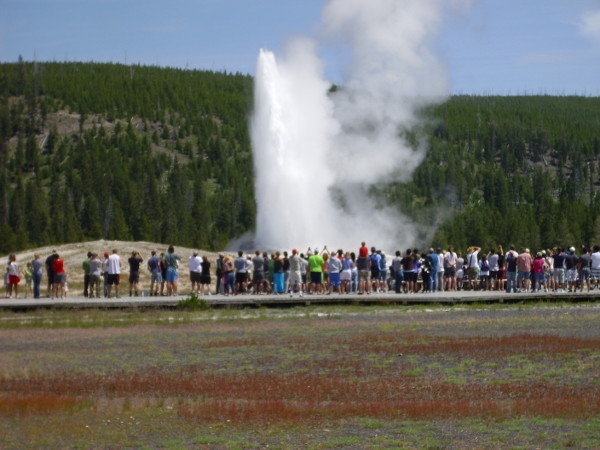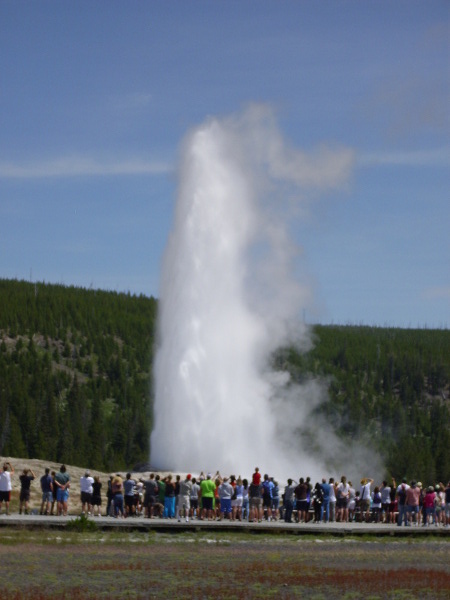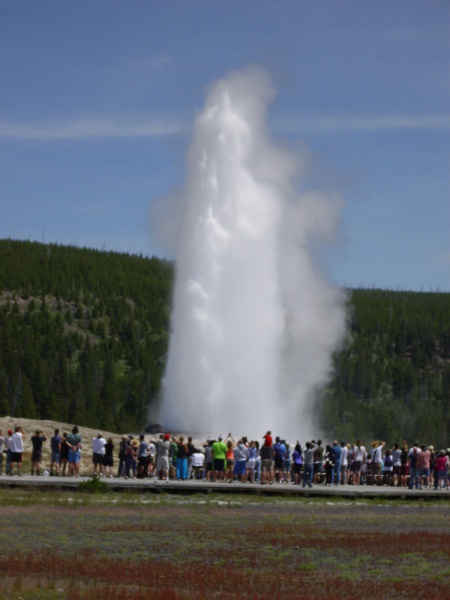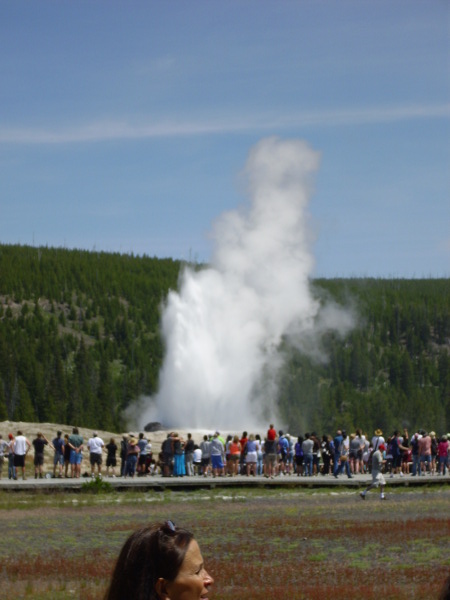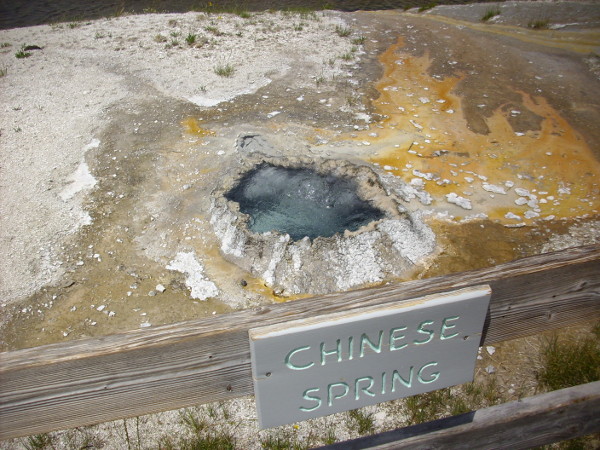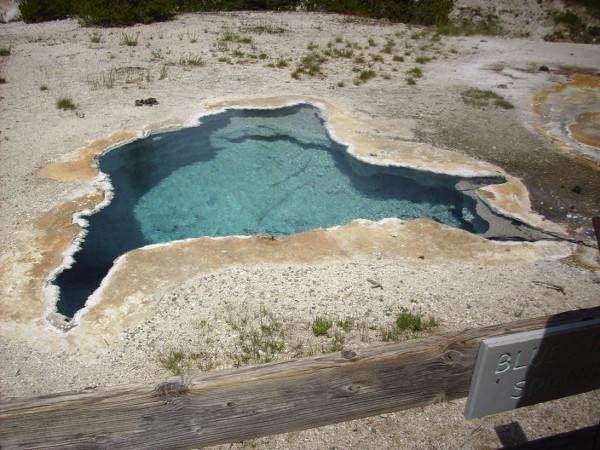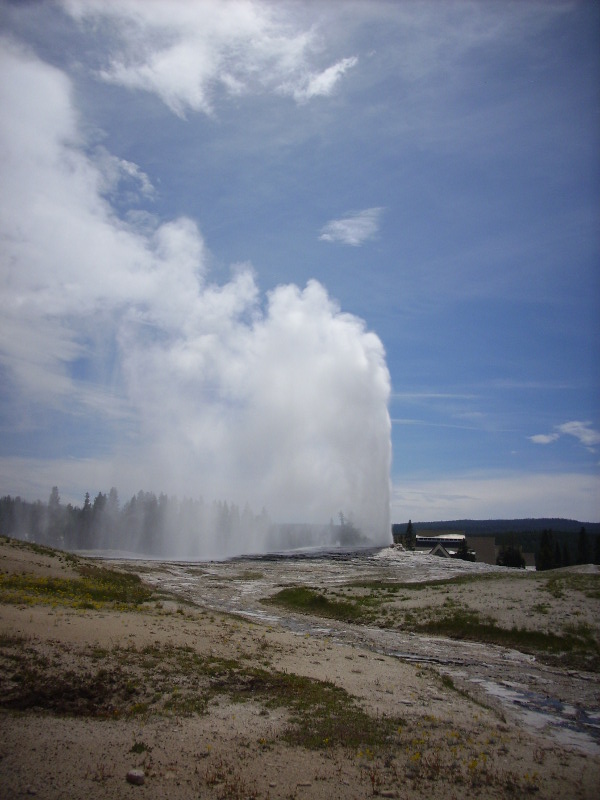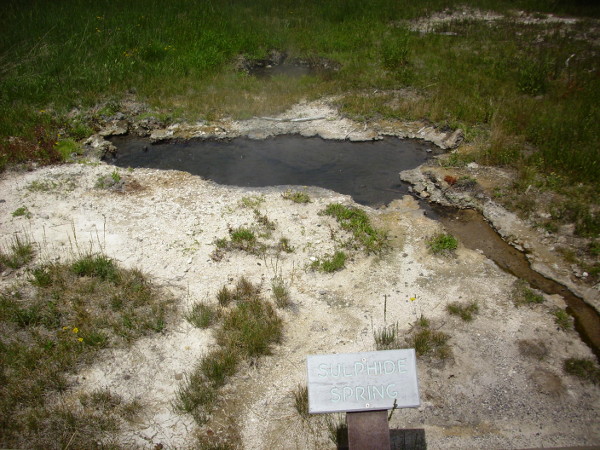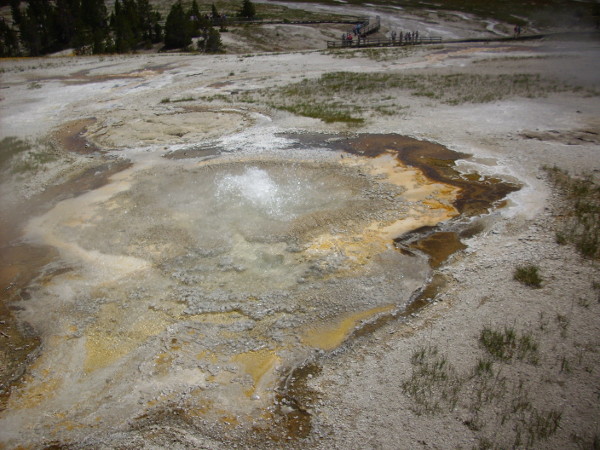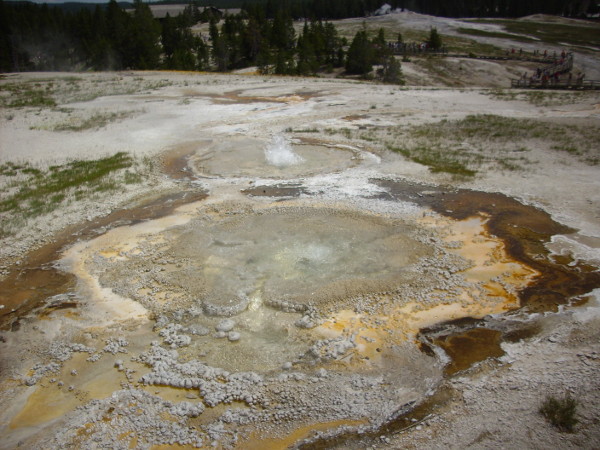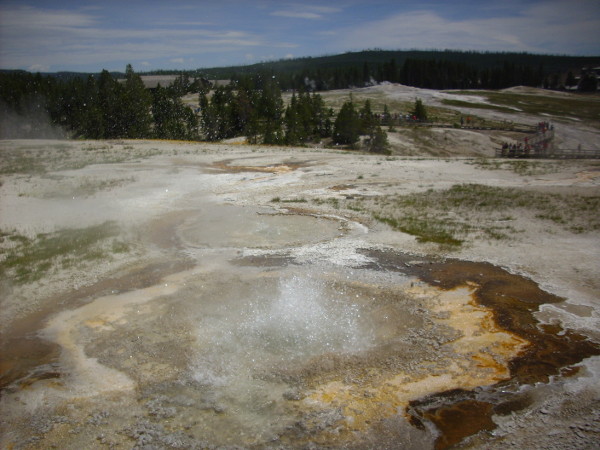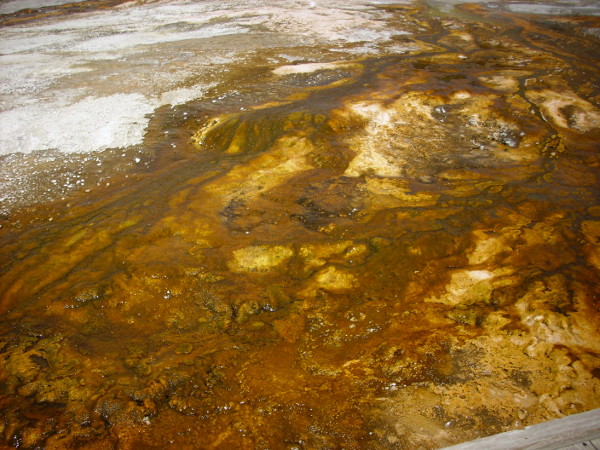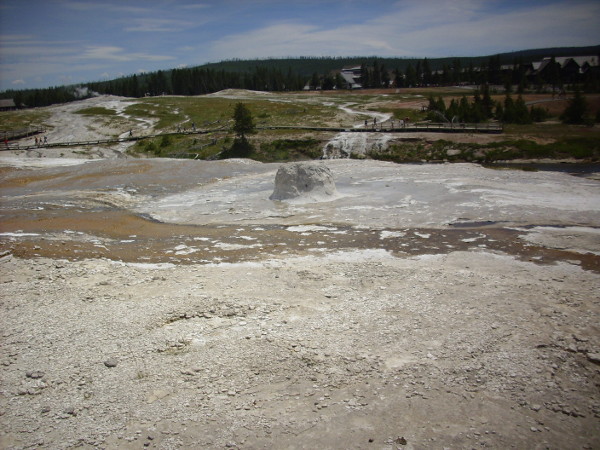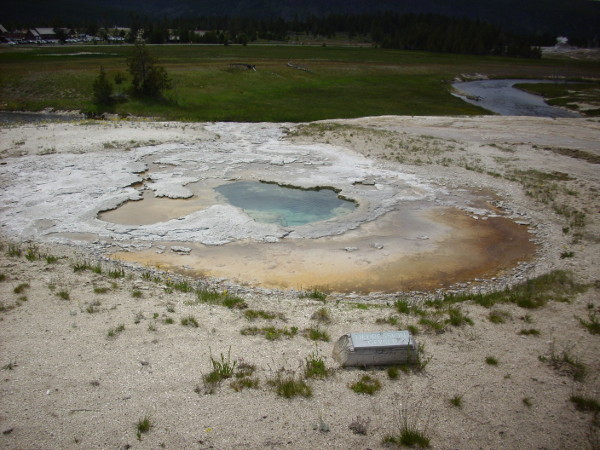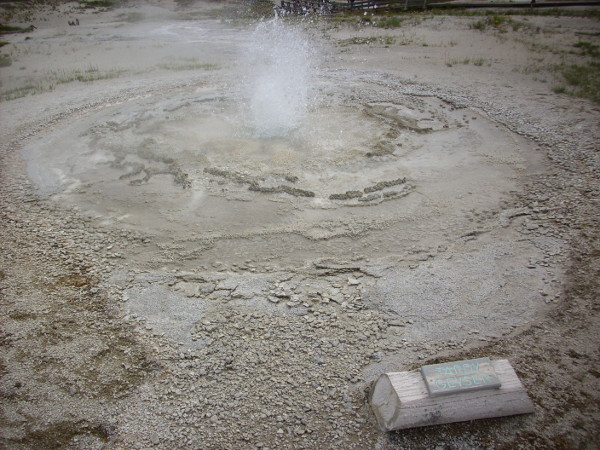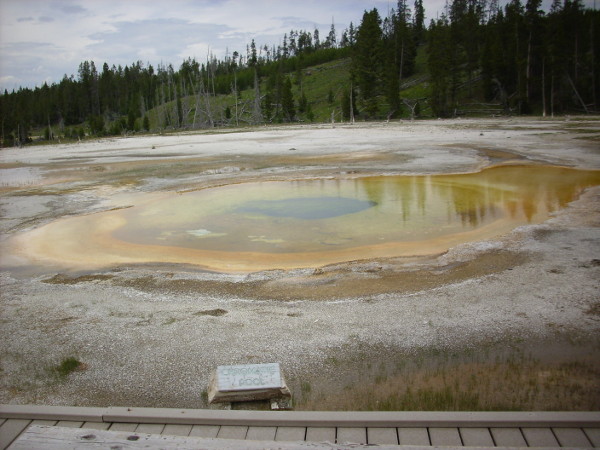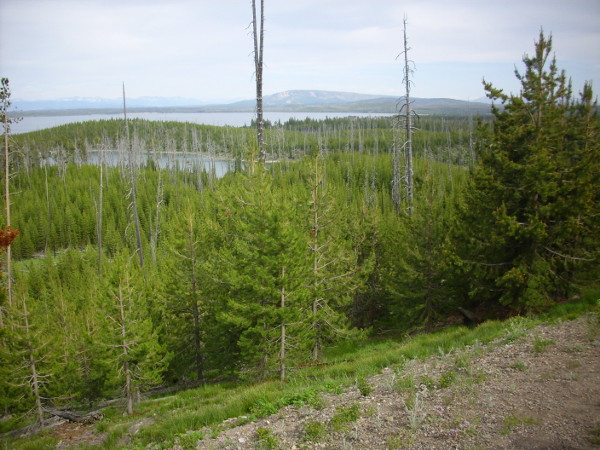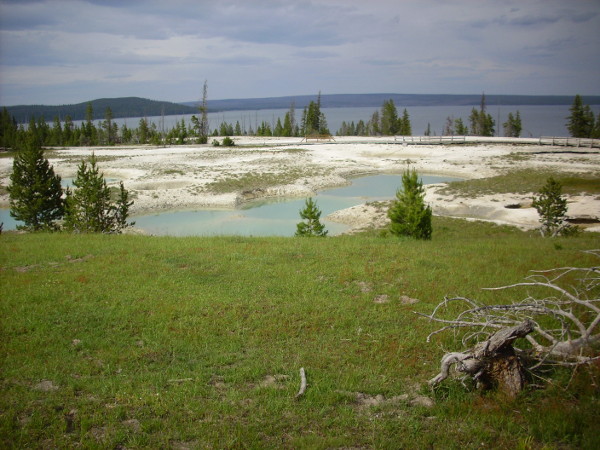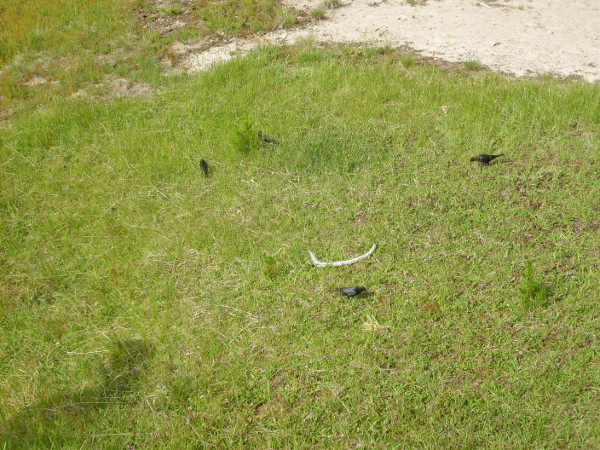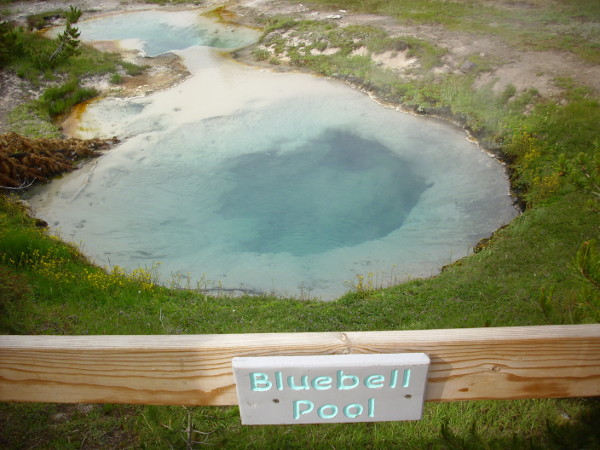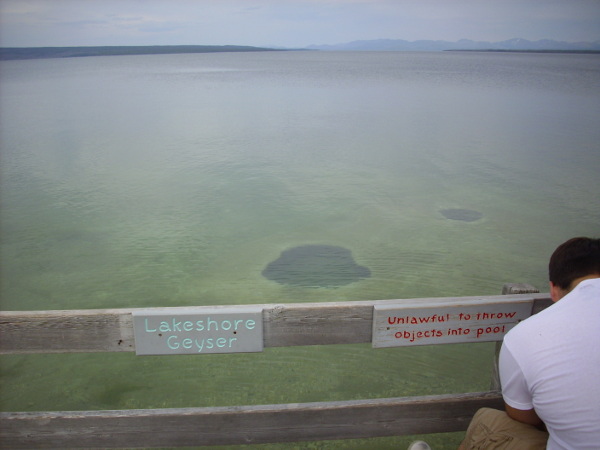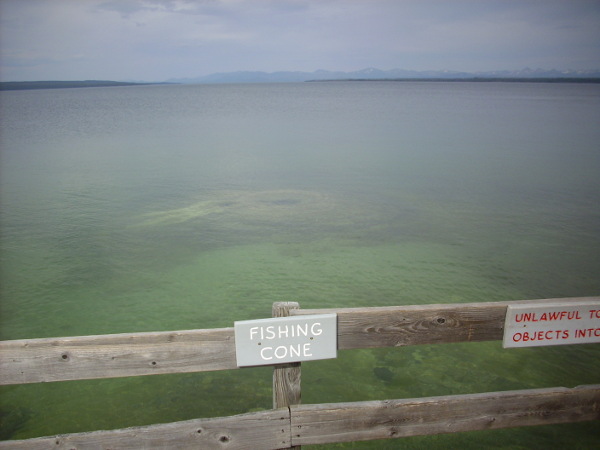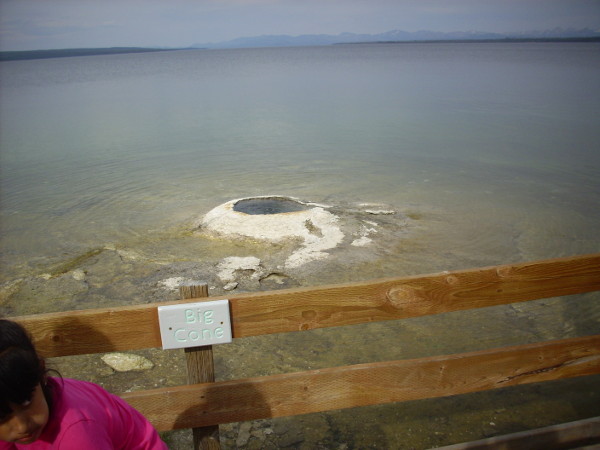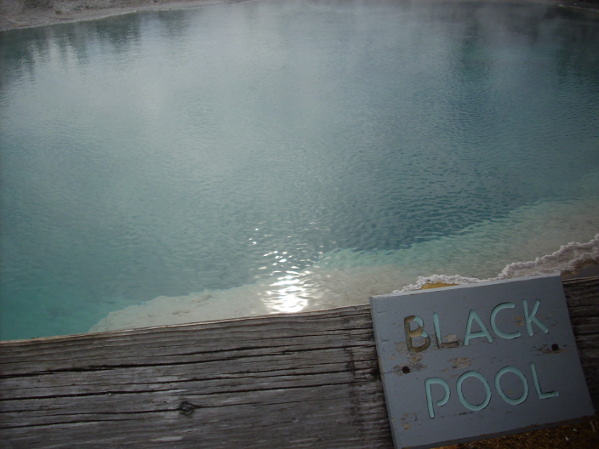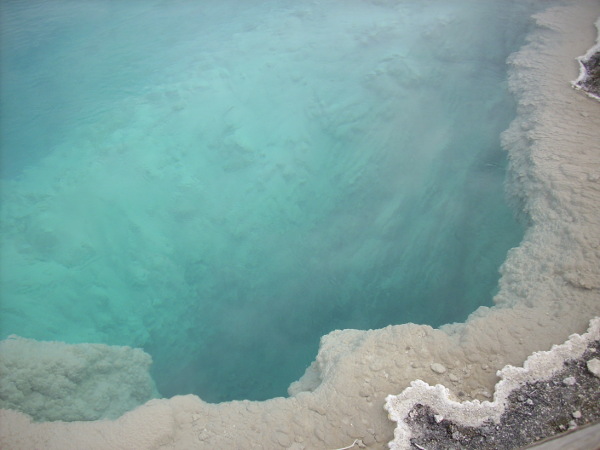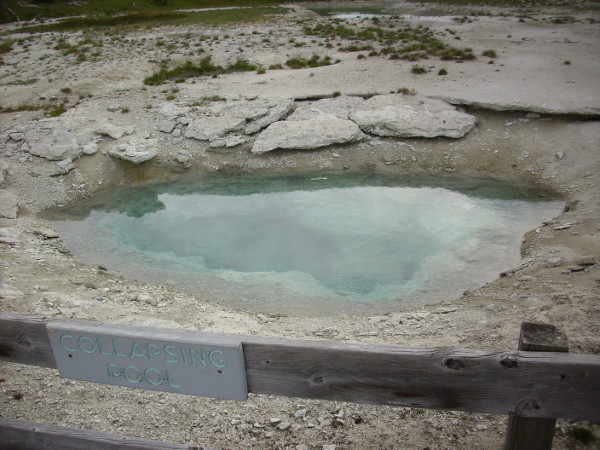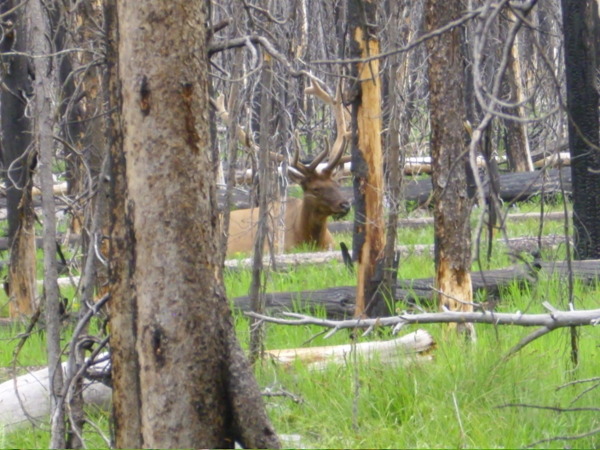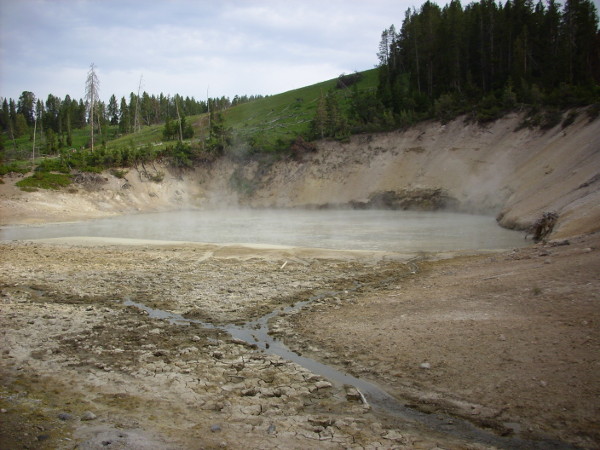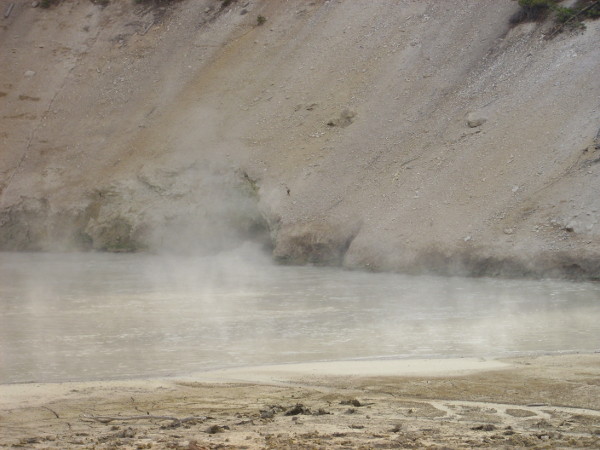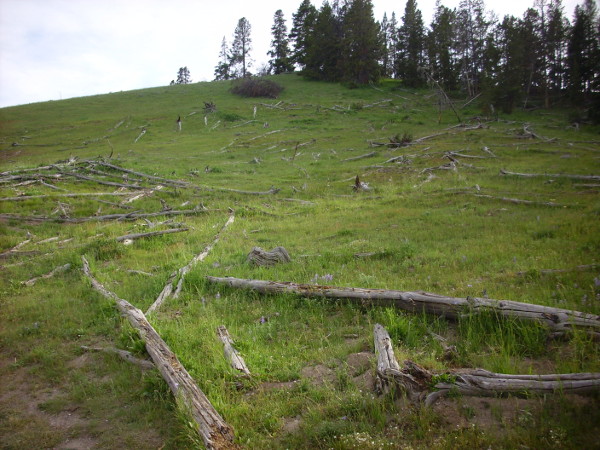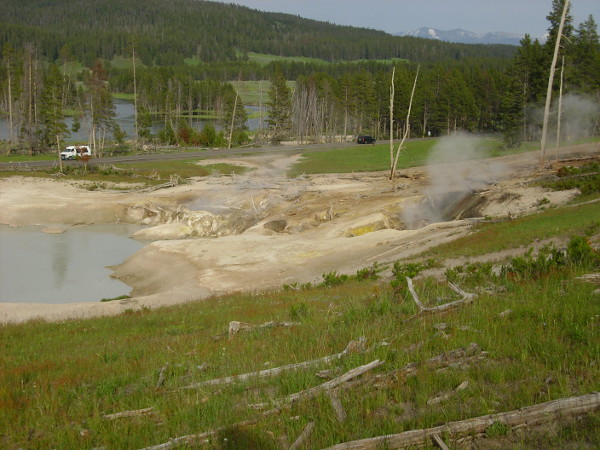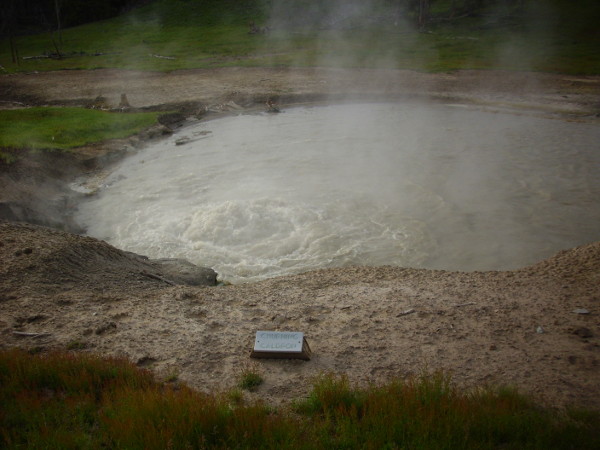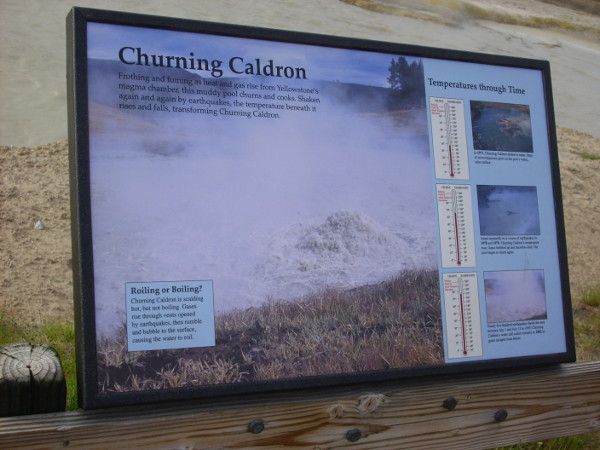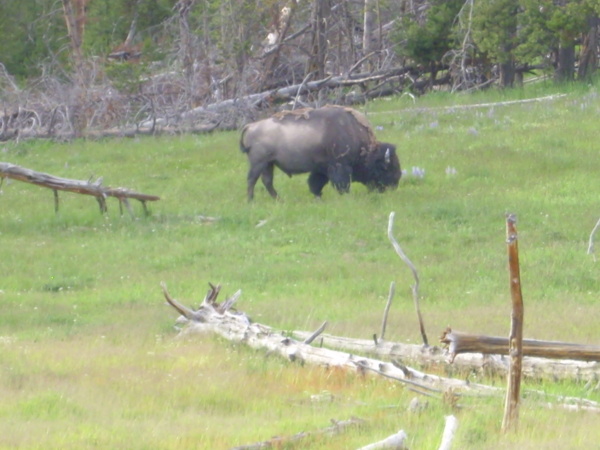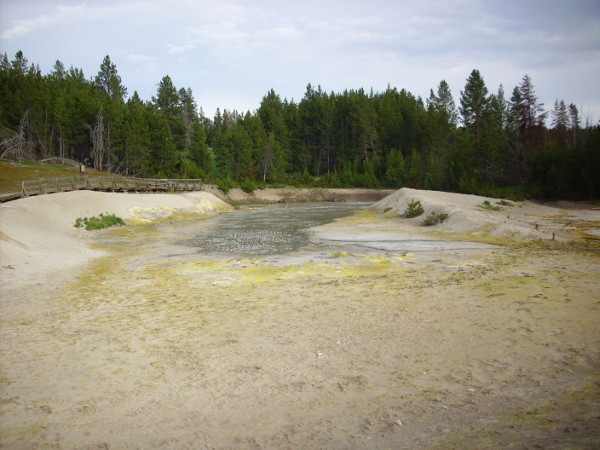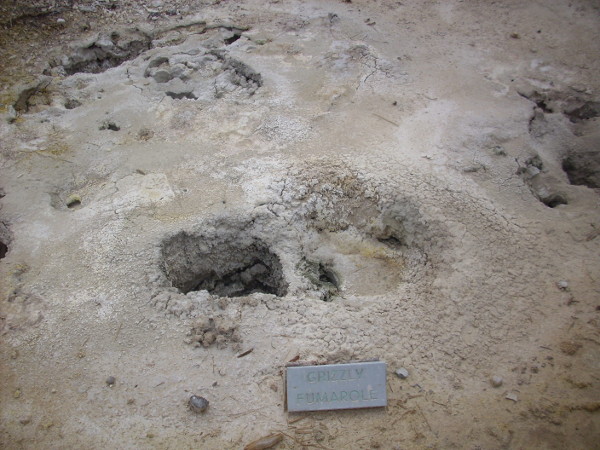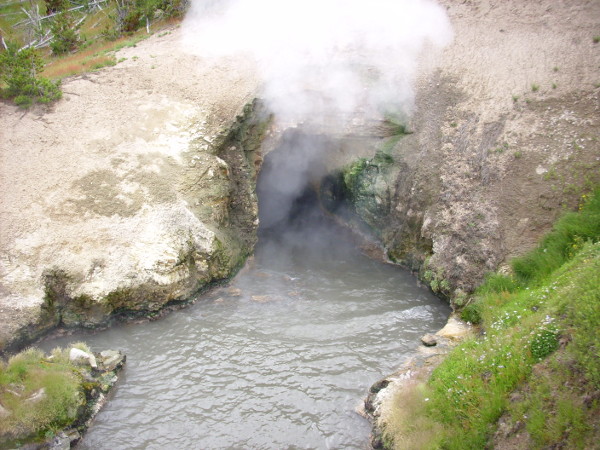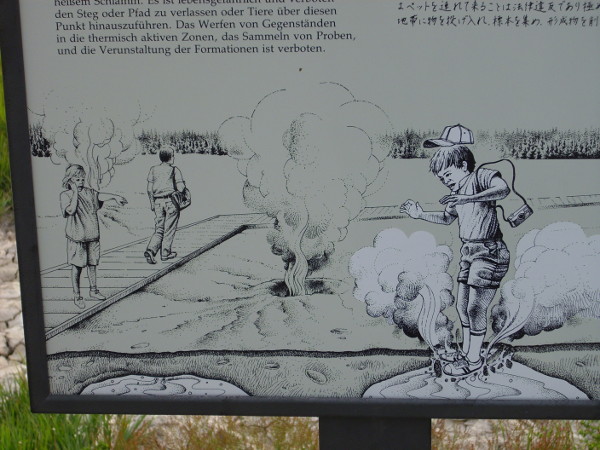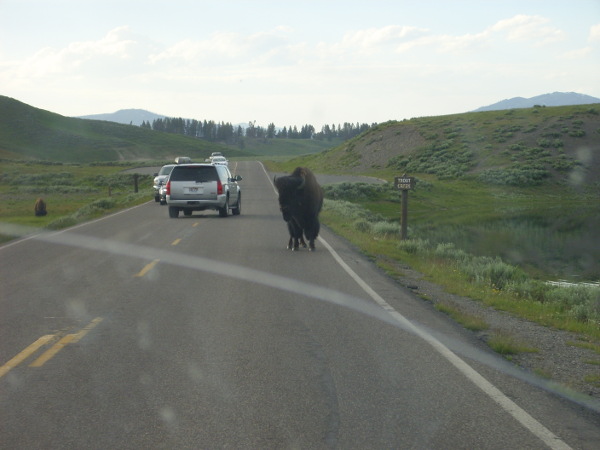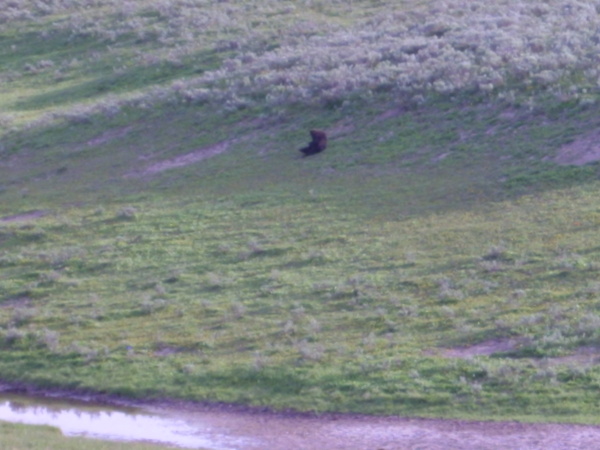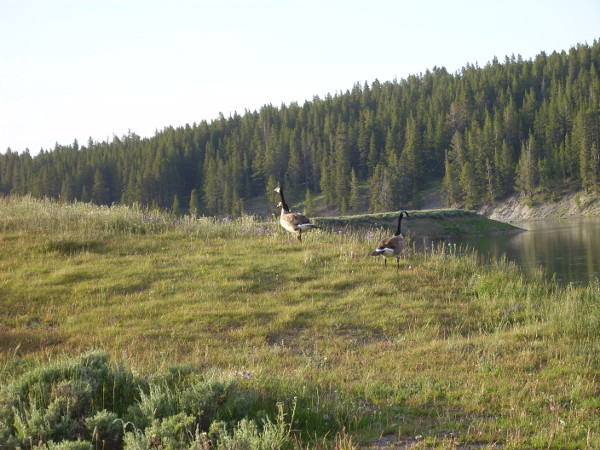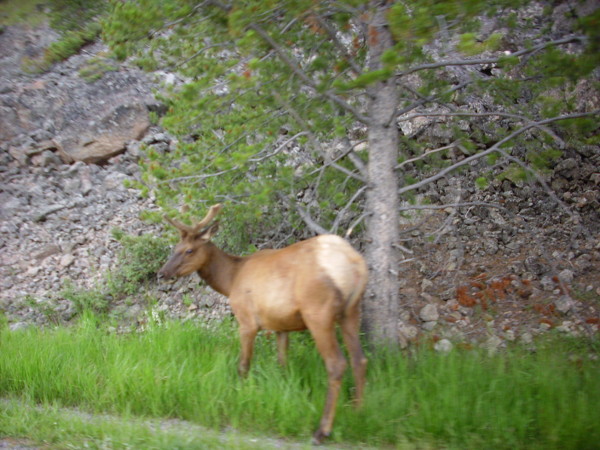Kent and Bruce’s Excellent Adventure, Day 9
Day 9: Geysers!
I was getting tired of oatmeal, so when Bruce mentioned that he had some extra discount coupons for Three Bear Lodge in West Yellowstone, I accepted his suggestion that we get a good breakfast. I got a fairly decent omelet, some cottage cheese (which the waitress very thoughtfully substituted for cantaloupe when I mentioned I was diabetic; did you get that name? Three Bear Lodge?) and sourdough toast with butter. Now, for me, sourdough toast is what Modern Politically Correct Cookie Monster would call a sometimes treat, but this was sometimes and I ate with relish.
From there it was back into Yellowstone. Wildlife!
To be honest, we were getting kinda jaded on buffalo by then. Still, this was the largest bunch I think we got close to.
Our first destination was the Firehole River loop and rhyolite flows. Rhyolite is a high-silica lava that tends to be erupted at a low enough temperature to be highly viscous, more like bread dough than fluid. Much of the Yellowstone Caldera is filled with rhyolite flows erupted after the last caldera eruption 64,000 years ago. This was rhyolite that probably had outgassed much of its volatiles in the caldera eruption; we were seeing the flat soda left in the bottle after you are done dropping in the Mento and seeing most of the soda come frothing out. (Is that the right singular for “Mentos”?) Lack of gas meant that this stuff did not erupt explosively, and because it was so “dry”, a lot of it failed to crystallize when cooling and became obsidian, volcanic glass, instead.
Here’s the face of a flow.
It looks a lot like one of the Yellowstone tuffs, unsurprising since they have the same composition (high in silica, low in iron and magnesium) but there are lots of little blobs of obsidian in the rock. (Click for a close up look.) Bruce noted that the interpretive sign was just a little lame:
because it shows pictures of modern-day basalt lava flows, there not being many big rhyolite flows in modern times. Or at least that anyone survived photographing. Basalt lava flows are almost completely unlike rhyolite flows.
Ah, purists.
The rocks made for some very nice scenery.
A road cut in the rhyolite.
Close up, showing some breccia. Because rhyolite lava is so stiff, it tends to form rubble, almost like a’a lava, which sometimes gets rolled up into the flow.
Then this, which got Bruce rather excited, then me when Bruce pointed it out.
Clearly a breccia, but the individual clasts (bits of rock) have the flat faces characteristic of glacial till. A glacier that picks up a rock tends to scootch it along for a ways, grinding one surface flat, then the rock hits a bump and gets turned, and a different surface get ground flat — producing characteristic angular boulders. The dark boulders look a lot like the Banco Bonito obsidian boulders in the Jemez, which you can see in road cuts and around Battleship Rock. But the Jemez never had glaciers, while Yellowstone was glaciated during many of the rhyolite eruptions. So this is glacial till, mixed with rhyolite or otherwise baked into a solid breccia.
We pulled over some distance past this point — it was a one-way road — and I ran back for a sample, which I brought back for Bruce to look at. Alas, my photos of the sample did not turn out. (I was still working out how to take good closeups.) Then I ran the sample back to the cliff, since you can’t take samples out of Yellowstone. (“Oh, Indian boy …” — Inside joke. I know, it sounds like it must be very politically correct, but in context it’s mostly Victorian British geologists being made fun of, and making fun of old white males is always politically correct, as I understand the rules.)
Then: More geysers! We first visited Lower Geyser Basin.
This pool’s chief claim to fame, alas, is that a 24-year-old once got himself boiled to death by trying to rescue a friend’s dog that ran into the pool. Notice how far the Park Service placed the boardwalk from the pool.
And its outflow, rich in thermophilic organisms.
Fountain Paint Pots. Paint pots and mud pots are hydrothermal features with a scant water supply, so that the mud formed by the acid in the water eating at the rocks isn’t washed away. This was also my first experiment with trying to use my little tourist Polaroid in video mode.
You will note my surprise that it actually worked. As well as my ignorance that my voice would be recorded. Yah, I get this all the time — I get payed $$ to program some of the most powerful computers in the world, but I don’t know how to work a cell phone or a video camera …
Red Spouter. This emitted a loud roar.
Not sure about this next one. Twig Geyser, maybe?
Spasm Geyser? We finally caught one doing something; you’d think I’d remember…
From there we proceeded to Firehole Lake Drive. Yes, the one that just got closed because the road was melting. It was just starting to melt when we were there, and I think we commented on it to each other.
Anyway. Firehole Spring:
Great Fountain Geyser. This one puts out a pretty good eruption about every twelve hours, but with a variance of about two hours. We discovered it was just getting into the eruption window when we got there. Bruce had a guide to Yellowstone geysers that described in detail its pre-eruption behavior, and it looked like we were at least 45 minutes out; the geyser was just starting to overflow its basin and bubble up periodically. It’s an unusual geyser in producing a mix of travertine and sinter, and the travertine is mostly responsible for its big distinctive basin.
Since it looked like nothing was going to happen immediately, we drove on to Firehole Lake, arriving just in time for a blort from Young Hope Geyser.
Seeing the activity, I dashed around the boardwalk to get close.
Didn’t blort long. Nearby Artesia Geyser just sputtered a little.
Then we drove aback around the loop to Great Fountain Geyser, only to find the parking lot a madhouse. We continued on to White Dome Geyser, just down the road from Great Fountain Geyser, figuring we had time to walk back up the road.
To our delight, White Dome Geyser began spewing as we were getting to trek down to Great Fountain Geyser. There was a Japanese family with their little boy there; the only Asian family I heard the entire trip who were definitely speaking Japanese. They were even more excited than we were.
Such a big dome; such a modest spew. Sigh.
Hiking back to Great Fountain Geyser, we encountered wildflowers worth photographing.
I kept my bucket of seawater ready.
We only got about halfway down the road before Great Fountain Geyser did its thing.
A pause, then a second blort:
At about this point the stream next to us became very lively, presumably from water overflowing from the geyser.
From there we drove to Upper Geyser Basin, in comfortable time for Old Faithful.
Which first taunted us.
But the real eruption soon followed.
It really is a sight to see. Icons get to be icons for a reason.
We had lunch. I had the buffet, which included buffalo chili. They taste better than they look. We then took a tour of the other geysers.
Chinese Spring. Apparently this was actually used by a Chinese immigrant as a laundry, for which tourists doubtless paid top dollar for the novelty. I have a vague recollection of Bruce noting that the practice ceased after the spring had a rare eruption and erupted boiling water and articles of clothing over the hapless laundryman.
Blue Star Spring. Such a lovely shade of blue. Very little in the way of thermophiles; too hot.
It had been a while. Glancing back, we see Old Faithful doing its thing again.
Sulphide Spring. Purists may quibble over whether this should, in fact, be Sulfide Spring.
Anemone Geyser. Actually two vents, Big Anemone (closer to the walk) and Little Anemone. Big Anemone erupts about every 10 minutes, while Little Anemone has a somewhat longer period. The two were more or less in synch when we arrived; in fact, Big Anemone caught me looking the other way, and showered me with hot steam and a few drops of very hot water (enough to be uncomfortable without doing permanent damage.) After erupting, water drains back into Big Anemone, looking and sounding for all the world like a toilet being flushed.
More thermophiles. “All your geysers are belong to us.”
Beehive Geyser, again. We never did see this one erupt.
Depression Geyser. As far as actually erupting, no deal.
More wildflowers. There were lots of these around. I speculated iris until I got a closer look and counted four petals; way off. Not even a monocot.
Sawmill Geyser was erupting when we reached it. Nearby Tardy Geyser, which usually erupts just after an eruption of Sawmill, duly did its thing.
Bruce made the interesting observation that any one of these features, if it sat by itself in your own neighborhood, would be a huge deal. Here, you get kind of jaded after a while.
We were originally intending to hike clear to Morning Glory Pool, but … you know … we were getting tired. Plus Castle Geyser looked like it might do something. We turned back, but missed any eruption by Castle Geyser, and decided we were done with Upper Geyser Basin.
So naturally we got in the car and drove to yet another geyser basin, on the west shore of West Thumb.
You may have noticed in my photos that there is a large forested hill east of Old Faithful. This is the Mallard Lake Dome, a resurgent dome formed when part of the caldera floor was pushed up by new magma rising beneath it. It’s very similar to Redondo Peak in the Jemez, complete with a graben down the middle. This is clearly visible on the horizon from one point on the road, but I slept right through it and missed the chance for a picture. I did get a shot overlooking Duck Lake and West Thumb.
Duck Lake is down in the trees. Beyond is West Thumb, a bay in Yellowstone Lake that is actually a small caldera — “small” meaning about half the size of Crater Lake in Oregon. This caldera erupted about 160,000 years ago in a series of perhaps three ash eruptions, all small compared with the three big Yellowstone caldera supereruptions. But they were enough to produce a deep crater a couple of miles across. Beyond West Thumb in the distance is Flat Mountain, which is part of the south rim of the Yellowstone supercaldera. My binoculars revealed red beds and other sedimentary rocks under a volcanic cap.
There is a geyser basin on the west shore of West Thumb that extends out into the lake. We took a look.
More wildlife. I don’t usually take much interest in little brown birds, but these seemed a bit better dressed than most. Click to enlarge (if you haven’t noticed by now, almost all these photos can be clicked to enlarge.)
By this point I was ready to photograph almost anything that wasn’t a geyser.
You can see a disturbance in the water in the background, which is probably due to another hydrothermal feature under the lake.
We apparently arrived at a time of high water. It used to be possible to stand on Fishing Cone to fish, then lower a freshly caught fish into the bubbling pool to be cooked on the spot. The rangers, they no like you do that any more.
Big Cone.
Black Pool. Part of this pool is very deep. Alas, I spotted no creature.
Collapsing Pool. Honestly, by this point, that seemed appropriate for us both.
Collapsing Pool is part of a chain of hydrothermal features thought to arise from a single deep fracture. Probably not the ring fracture of the caldera, though I can’t entire rule out the possibility.
From there it was off to see something besides a geyser for awhile. We drove along the west shore of Yellowstone Lake. Bruce got wondering why I kept looking over my shoulder to the southwest, until I explained I was hoping to see one of the southwest-trending extensional gulleys coming down from Elephant Back Mountain. And we saw … Wildlife!
Big traffic jam ahead; as with most at Yellowstone, it was due to a wildlife sighting. In this case, a ginormous elk.
He seemed happy to pose for all the monkey-boys on the road, at least until a couple of tourists started creeping too close.
From there to Mud Volcano in Hayden Valley.
This is a relatively small hydrothermal basin, but one that has shown dramatic recent changes.
Including hot springs erupting into the storm sewers, and the sulfuric acid eating out the storm drain grating. Bruce, as a one time environmental engineer, found this highly entertaining.
Mud Volcano.
A nearby hillside is covered with dead trees. This was not forest fire damage. It was due to the hydrothermal activity shifting and the ground a few inches below the surface heating to temperatures in excess of 150 F. No tree can stand that.
Evidently it’s bubbling from carbon dioxide, not steam. Al Gore should get right on it.
More wildlife. We saw several in the area. They like the warmth, I suppose.
Black Dragon Cauldron. I saw no undead, unless you count Bruce and me.
Grizzly Fumarole. This would shortly prove ironically appropriate. (<– foreshadowing)
The Dragon’s Mouth. You do indeed hear what sounds like a rather large dragon breathing rather heavily back in there.
All over Yellowstone you see signs like this one.
This tells you not to let your kid boil himself in three or four languages. Bruce and I snarked about its stereotypicality: The boy wearing what appears to be a Cub Scout hat, recklessly plunging into boiling mud; the mother screaming in horror; and the father walking off completely oblivious. We had to take a picture, if only as future Photoshop material.
It’s a Park Service sign, so it’s doubtless in the public domain. I hereby place this one photograph in the public domain as well. Have fun with it.
Yet more wildlife.
Another common sign in the park, which I did not think to take a picture of, appears to be a pictograph for “Yield lane to wildlife.”
Big, big traffic jam ahead. Turned out that in the valley below the road, there was a grizzly bear gamboling along. Half the world’s tourists had pulled over and pulled out everything telephoto in their inventory. Well, why not? I made excellent use of my binoculars, which showed the big fellow having just the time of his life wandering around, uprooting stuff and enjoying the evening, unconcerned about all the monkey-boys watching. Alas, he was too far away for good photography; this is the best I could do.
Not sure what he was doing there. A handstand?
We watched for several minutes. Eventually even a grizzly bear gets boring if he’s half a mile away and heads into low scrub, so we moved on.
And saw a gaggle of geese.
And, to wrap it all up, a single young elk on the roadside, tempting Darwin and eating fresh tree shoots.

